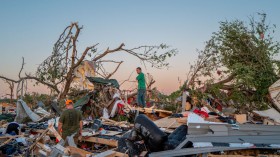The island nation of Kiribati is sinking due to both rising sea-levels and its increasing population. About half of the total head-count, some 50,000 people, is already packed into a small sand strip that measures six square miles.
For many years, countries such as Kiribati (pronounced Kee-ree-bahs) and Tuvalu have been slowly sinking. But, a new report from Reuters suggests that Kiribati's problems might not just be the result of a warmer earth.
Few reasons cited for the population boom in the country are local traditions favoring large families and the restrictions of family planning by the Church.
The annual population growth of Kiribati is about 6 percent with about 36.1 percent of the population under 15 years of age. Overcrowding is a major reason for disease and infant mortality in the region.
"Climate change is a definite long-term threat to Kiribati, there's no doubt whatsoever about that," says Simon, a climate scientist at the University of British Columbia, reports Reuters."But that doesn't mean it's the biggest problem right now ... Any first-time visitor to Tarawa is not struck by the impacts of sea level rise, they're struck by how crowded it is." Donner has been visiting South Tarawa, a tiny atoll in the region, since 2005. The atoll is just three meters above sea-level.
Anote Tong, President of Kiribati has predicted that the country will be uninhabitable in the next 30 to 60 years due to rise of sea level and contamination of freshwater. Previously, Tong had said that the nation is planning to move its entire population on man-made islands. There are also plans of the nation being shifted to one of the islands in Fiji.
© 2024 NatureWorldNews.com All rights reserved. Do not reproduce without permission.

![Bison Herd Consisting of 170 Reintroduced Individuals in Romania Could Store Carbon Emissions Equivalent to 43,000 Cars [Study]](https://1471793142.rsc.cdn77.org/data/thumbs/full/70533/280/157/50/40/bison-herd-consisting-of-170-reintroduced-individuals-in-romania-could-store-carbon-emissions-equivalent-to-43-000-cars-study.jpg)



